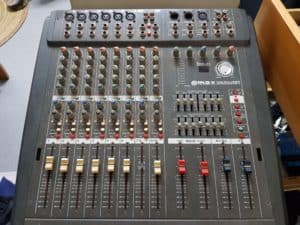Aux send and return channels have become indispensable in my audio mixing workflow, whether I’m working on live sound or studio recordings. In this post, I’ll walk you through how to effectively use these features on your mixer. By mastering the management of effects like reverb or delay through aux channels, you can maintain a clean main mixer interface and ensure your sound remains pristine. Whether you’re just starting out or you’re a seasoned professional, mastering this technique will significantly enhance your audio projects.
Not every mixer is the same, on some mixing desks you’ll have inputs labeled as “Aux returns”, “Aux sends” (BUSes). On some conventional soundboards, there will be 2 – 4 Aux sends, and no Aux returns, (in that case return channel will be the one that is used for returning the sounds signal for example, from effect unit) while on some advanced mixers there can be 6 and even more Aux sends and a couple of stereo Aux returns.
You may notice “Insert” jack right below your “Line in” jack on your console. What is it for? Insert what? That insert channel serves, believe it or not, as both, input and output. It acts the same as direct out as well as returning signal back to the soundboard. Already interesting? Complicated maybe? I hope I haven’t confused you. Keep reading, this is just a warm-up. You might be interested in my post on the built in effects on the Behringer X32 mixer.
Various uses for aux send and return
There are many approaches to Auxilliary send and aux return channel usage in a live sound environment, for example:
- Monitor mix
You’ll be able to create several monitor mixes or headphone mixes that are different from the main sound mix the audience hears, just for performers so they can hear themselves while playing live or in the studio.
- Private communication
You’ll be able to make private communication between musicians, the sound desk and the stage. This obviously works better with in-ear monitors.
- external effects processor
You’ll be able to route a primal signal to the external FX unit such as delay, reverb, limiter, compressor etc.
- Recording different mixes as well as a main mix
You’ll be able to send only the signal you want to record to a track. You can simultaneously record a couple of different mixes at the same time.
- Creating a submix as well as your main mix
You’ll be able to create a main mix and a sub-mix (mostly used for drums). You can route all drum components to one channel fader only.

Tips for using a mixer fx processor unit
If your mixer doesn’t have an inbuilt effects processor or you just want to use some external sound effect such as reverb and delay, aux send and aux return can help with your mixing. Let’s say you have reverb and want to use it with your mixer there are a couple of ways to do that using aux send and aux return inputs:
- You can use an insert channel jack (you’ll need “Y” cable). As we said, insert input is sending and returning the signal to your mixer. With this method, you’ll be able to add effects only at the channel that the FX unit is plugged to. Put stereo jack (the one with 2 rings on it) in your mixer’s insert input, and other two in the unit’s “in” and “out”. Using this method, you can adjust the amount of the effect(s) mix.
- You are probably wondering whether you are able to process several instruments through a single FX unit, only. Yes of course, but you can use only one setup for each channel, which is not a disadvantage at all.
- You can also route entire FX signal to one of the channels on your mixer and treat it like separate audio signals. You’ll be able to tweak settings, adjusting EQ, putting the noise gate on effect, etc, without affecting the instrument’s primary sound.
Let me explain to you step by step on using an external FX unit with your mixer. Let’s say you want some reverb and delay added to your channels dedicated to vocals. Assign these channels to an Aux Out on your soundboard. Insert your cable to the Aux Out channel on your console and the other side of the cable to your outer FX unit’s “IN” jack. After you did that you’ll have signal processed to your effects processor. Now we need to route it back to the mixer. On the backside of the unit, probably right next to “IN” there is “OUT” jack. With another cable, connect the FX “OUT” and mixer’s “Aux Return” (if you have it on your soundboard). Using this method, you’ll be able to adjust the amount of the effects with the Aux knob. This method is usually used when the reverb or delay doesn’t need to be 100% wet.
What about when we want to use an effects processor that requires 100% wet signal, like a compressor, limiter, noise gate, EQ? Then we have to use an “Insert” jack. Like we said before, you’ll need “Y” cable. That is a cable with one stereo jack from one side and 2 mono jacks from another end of it. The Stereo jack should be plugged into the insert channel on your sound board, while the two mono jacks should go to the effects processor. One mono jack to the “IN” and other to the “OUT”. The cable which is plugged to “In” will send a dry signal from the mixer to the FX box. The other cable which is plugged to “Out” sends (returns) the processed audio signal from the device back to the mixer.
Monitoring and aux send
The ability to create a different live sound main mix on stage, which will serve as the stage or in ear monitor mixes for musicians, is an incredible advantage that Aux send feature on your soundboard can provide you with. Usually, on the backside of the sound desk, there are sockets named Aux Sends which can provide you with the output signal. We suggest you use balanced cables since with unbalanced cables there is a much bigger chance for unwanted noise, buzz. If you have active stage monitors, that is awesome! You won’t need an additional amp for monitor speakers. After you have connected your monitors or headphones amp, you’ll be able to adjust the level control of each mixer channel.
On the upper right side of a live sound board usually, there is Aux sends knob with which you control general output for Aux sends. That determines signal level you will feed the monitors. After you turn it up to some level (don’t go too much) on auxilliary send, you can go through every channel and set the desired monitor levels. When you are satisfied with the monitor mix, you can check number of levels you route it by pressing AFL. Same as for gain staging, on the dB meter, you’ll be able to check on how much volume you send to monitors. Keep the volume controls around 0db. Be aware that Aux sends are typically post EQ. So, tweaking the EQ knobs on the mixer will directly affect the monitor mix and main mix as well.
You may notice that on some mixers there are the Aux sends which have pre-fader and post-fader feature. What does that mean? That means that you can choose whether the signal will be sent pre (before the fader) or post (after the fader). There is usually a switch button for pre or post-fader. The signal that you are going to use for monitor mixes should be pre-fader while for the effects processor it should be post-fader. That decision is up to you.
What is a monitoring pre-fader?
As we mentioned, pre-fader aux send outputs are commonly used for the monitoring because it won’t change its volume when you control the main L/R fader. Even when the channel fader is all the way down, the signal from that channel is still being sent through the “Aux sends” output. Simply, when you bring the volume on the channel or master fader up or down, monitor mix will remain at the same level. A signal pre-fader is very useful because it enables the musician to hear himself while playing no matter strength of signal is sent on the master. It’s worth reading over the section of your mixing console manual about using a pre-fader, as every console is slightly different. I got caught out on a Yamaha desk, not realising that pre-fader options only worked on aux 1 and aux 2 and not 3 and 4.
What is a post-fader?
Opposite to pre-faders, a post-fader Auxilliary sends output on the mixer. When you push the channel fader level control up, the Aux send output level will go up also. You’ve been probably wondering why post-fader Aux sends is regularly utilized for external effects processors. Let us explain by example. Let’s say that you have a vocal channel, on which you added delay and used pre-fader sends. If you bring the fader down, the delay will remain at the same level and that is not something you want right? But if you are using post-fader Aux sends, since in that case, the fader control affects the Auxilliary send level, each time you bring up or down channel fader, the signals of the effects applied will go up or down simultaneously. If you’ve ever wondered how a post-fader works, hopefully this has helped explain.
Source: https://www.mediacollege.com/audio/mixer/pfl.html

Leave a Reply